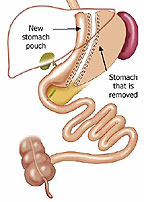Gastric Sleeve
Sleeve Gastrectomy
The sleeve gastrectomy is constructed by removing 85 percent of the stomach creating a small pouch. This allows for smaller amounts of food consumption while providing a feeling of satiety sooner and for a longer period of time.
By creating a smaller stomach pouch the production of Ghrelin a hunger hormone also decreases. Eating less will allow the body to stop storing excess calories and start using its own fat supply for energy.
The sleeve gastrectomy will not alter the stomachs digestive and absorption. The stomachs function remains intact with less capacity to hold food but allowing for full absorption of vitamins and nutrients into the body. Health benefits from weight loss surgery can aide in decreasing or providing remission of comorbidities that have resulted from obesity.
Similar to our other surgical weight loss options, sleeve gastrectomy patients may experience the following benefits:
- Decreased or complete remission of health disorders resulting from morbid obesity*, such as:
- Diabetes
- High blood pressure
- Gastric reflux
- Sleep apnea and other conditions
- Increased mobility
- Improved psychological wellness
- Improved social interactions
- And, most important, overall improvement in quality of life
*Improvement or complete resolution of medical problems is not guaranteed and they may recur if weight is regained.
What The Procedure Involves And How It Works

During the Sleeve Gastrectomy, the stomach’s capacity to hold food is reduced by removing approximately 85% of it, leaving the remainder as a tube or in the shape of a banana. Similar to other bariatric procedures, this produces a feeling of fullness after eating a much smaller meal allowing the patient to lose weight by eating much less at each meal (restriction). Because the portion of the stomach that is responsible for producing an appetite stimulating hormone (Ghrelin) is decreased, the patient’s hunger is also diminished by biochemical means similar to what is achieved with gastric bypass.
Originally designed as the first step in a malabsorptive bariatric procedure, the sleeve gastrectomy has become a popular standalone restrictive operation. The sleeve typically holds 50ml to 150ml and is approximately the size of a banana. Some patients may experience the added benefit of a decrease or remission in comorbidities related to morbid obesity. To qualify for surgery a patient must have a BMI equal to or greater than 35-39.9 with an illness associated with morbid obesity or a BMI of 40 or greater with no comorbidities.